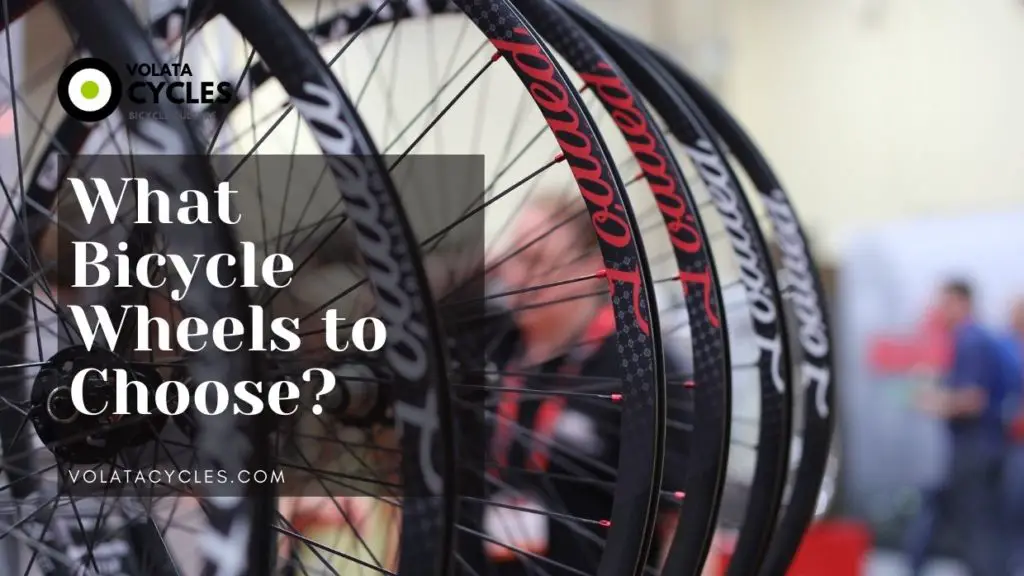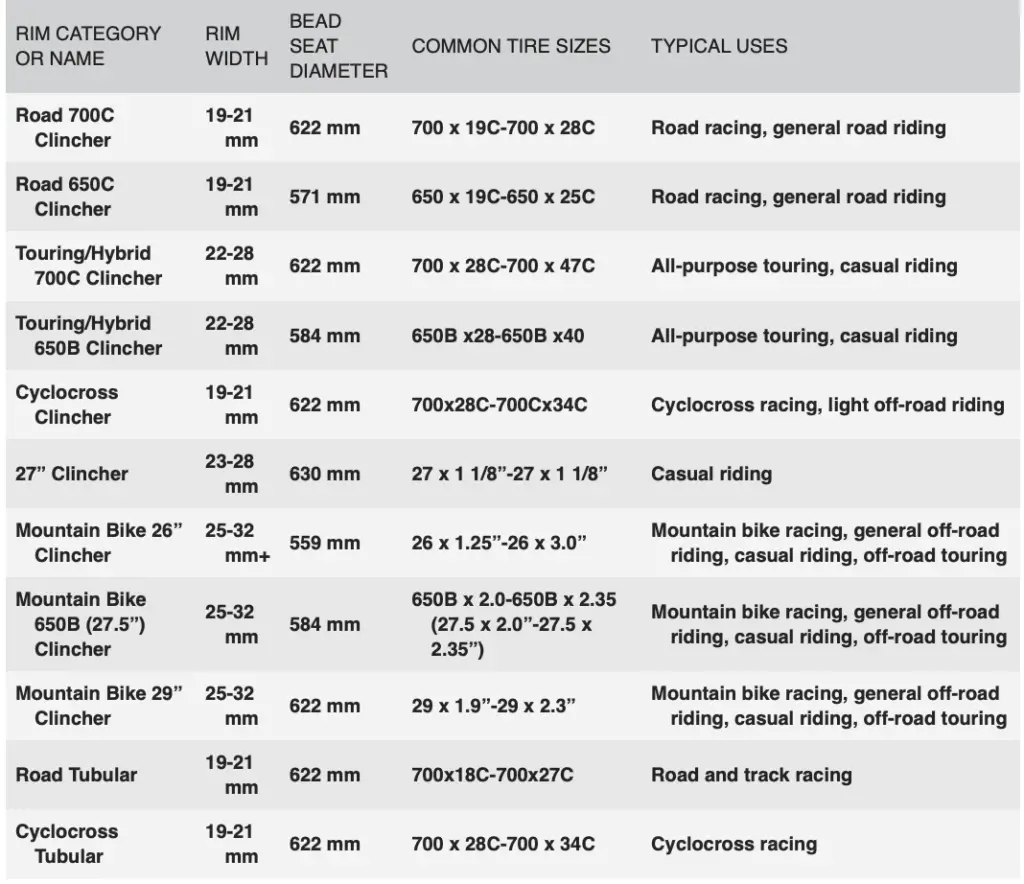Choosing bicycle wheels is a tricky task. There are so many choices and factors to consider! Which size do I need? What type of rims? What spokes should they have? How many spokes should the wheel have? These questions may seem daunting, but with our help, we’ll walk through some things to consider when selecting the right bicycle wheels.

Most bicycle wheels are built to the same size and specification, ranging from 12-inch to 29-inch diameters and 3/4-inch to 3-inch widths. The most prevalent rim and tire numbering systems are the English-American and European standards. Although many wheels within a system may be replaced, the precise tire-to-rim fit is unique to each one.
The English-American system uses two-digit numbers to indicate inches from approximate wheel diameter (tread to tread). Then a tire width number is expressed as a decimal. 26 X 1.9 indicates a wheel with a diameter of about 26 inches and a width of about 1.9 inches, for example.
A smaller diameter, lower profile tire is required for the newer standard of 26-inch wheels. This standard was most popular among British three-speed bicycles with 26 x 13/8 tires. A decimal-sized tire is not known as 26 inches because it doesn’t exist; rather, a fractional-sized one is called that.
The European system is based on the metric system. A three-digit number determines the approximate diameter in millimeters of a mounted and fully inflated tire—the wheel diameter is 650 mm. This figure is sometimes followed by a two-digit number indicating the tire width in millimeters. Typically, after one of these numbers, a letter (A, B, or C) indicates rim diameter: for example, the 650 X 23C has a roughly 26-inch diameter when fitted with a tire.
The standards have been bent according to creative interpretations. Some European standard sizes were originally defined based on dimensions used with dissimilar tires now in use.
The diameter of 700C is a good example. If you measure the diameter of a 700 x 23C wheel and tire, which is typical to almost every road bike, you will find that it doesn’t reach nearly 700 millimeters (about 27.5 inches). In reality, you’ll probably get a measurement closer to 675 millimeters (about 26.5 inches). This is most likely due to the fact that the original standard was based on a tire size of 700 x 35, whereas both tires fit on the same rim due to the smaller 23-millimeter tire diameter.
650B is another example, which had been forgotten for some time but is gaining popularity as an alternative wheel size for mountain biking. Again, the 650 designation implies a diameter of roughly 25½ to 26 inches, however with a contemporary 2.0-inch off-road tire installed, the wheel measures around 27½ inches in diameter.
The diameter of the wheel, rim width (this figure affects tire choice but isn’t mentioned formally), and tire size are just a few things to think about while selecting wheels.

Important wheels components to consider
Wheel diameter
The frame designer decides how big the fork and stay should be, depending on the size of the frame. The majority of road bikes built for 27-inch wheels will not fit 700Cs. Some will, but to be sure, do a test fit. Surprisingly, it’s feasible to put 700C wheels in some mountain bike frames to make them more suitable for road riding. When attempting these swaps, always check that the brake pads reach the rims (don’t buy until you’re positive they’ll fit).
Bead seat diameter
The bead seat diameter is the bead seat diameter, which is determined by the tire’s tread width. There is a dimension known as the bead seat diameter (BSD) within each wheel size category. This is a measurement inside the rim through which the tire’s bead, or thick wire at the edge of the casing, interfaces. The BSD for every tire size standard is consistent and unique. For example, a 700C rim always has a BSD of 622 millimeters. This explains why one rim may accommodate many different tire sizes.
Rim width
This might influence the type of tire you choose. Although there are no strict rules for rim-tire compatibility, most rims will accommodate various road-tire sizes. A narrow rim with an outside width of 20 millimeters, for example, will generally fit tires with widths ranging from 19 to 35 millimeters. Make your rim selection based on the range of riding conditions you want to encounter. On page 49, find out which tires are best suited for various riding. Then select a compatible rim after finding out which tires you’ll be using.
Tire size
When purchasing road and dirt tires, keep in mind that although manufacturers are trustworthy when specifying diameters, their method of indicating width is unreliable. One firm’s 25-millimeter tire may be the same size as another’s 28. Another maker may label a 26 x 1.75 tire as 26 x 1.5, resulting in an incorrect size. You can only determine the size of a tire by measuring its breadth while it’s inflated.)
A five-digit sequence known as the International Standards Organization (ISO) tire size system might help to alleviate this issue. Despite the fact that tire experts are familiar with and follow it, consumers are just beginning to discover it as a recommendation for tire selection.
Like other components of a vehicle’s suspension system, Tires vary in size. Other factors include the casing construction and tread pattern, among others. Keep in mind that coarser casings (which means larger and fewer cords, around 30 to 60 threads per inch, or TPI) usually produce a stiffer and more durable tire, while finer casings (100 TPI or more) yield a more supple, smoother-riding tire with greater inflation pressure tolerance but less resistance to scuffs and cuts.
The tread pattern, or lack of tread pattern, on the tires you choose is designed to match the road or trail you will be traveling. Tires with shallow tread patterns are used on hardtop surfaces such as paved roads, concrete and board tracks, and hardpacked multi-use paths. Dry, loose ground off-road tires require a lot of giant knobs, while wet, muddy conditions require tires with more widely separated knobbies that don’t get clogged with muck.
Frequently asked questions
What’s the difference between a 406 and a 451 wheel?
Since they have more momentum and provide greater comfort than 406 tires, 451 tires are also larger. They’re small enough to transport conveniently yet powerful enough for punchy acceleration and responsive handling.
Is it true that bigger wheels are better on a bike?
Small wheels on smooth surfaces have less aerodynamic drag because to a smaller frontal area. Smaller wheels can also be made lighter (hence more readily propelled uphill). On the other hand, Larger wheels are theoretically more rolling resistant (the impact of this is minor).
Lighter bike wheels are typically better; why?
Lighter bike wheels are typically better because they accelerate quicker and climb hills easier. Bicycle wheels being lighter makes them easier to spin fast, which increases the amount of energy produced to propel a bicycle forward. Lighter bike wheels also have a smaller surface area to be in contact with the ground, reducing the amount of friction experienced. This means that less energy is lost from being used up for this type of movement.
Final Words
Bicycle wheels serve various purposes, from providing stability while riding to holding the tire in place on the rim. Bicycle wheel sizes vary according to their intended use and what type of bike they are installed on. So choose wisely when selecting your next wheelset.
